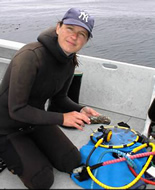Exploring the Hidden
Byways in the Life of Microscopic Larvae
Faculty member studies the travels
of whelk larvae for insight into dispersion patterns of marine
life
May 27, 2005 ::No. 224
Most marine animals begin their lives
with a mysterious odyssey — mysterious, at least, to
humans in the scientific community.
Life for such animals as mussels, sea stars,
urchins, rockfish and snails starts as microscopic larvae
floating in ocean currents that potentially carry them far
from where they originated.
Where do they come from? Where do they end
up? Or do they simply disappear?
“We know where the adults are, and we
know they produce buckets of larvae, but we don’t have
any idea where the larvae end up,” said Danielle Zacherl,
assistant professor of biological science at Cal State Fullerton.
She is studying a representative snail species called Kellet’s
whelk.
Zacherl is in the midst of a three-year study
supported with $232,778 in grant funding from the National
Science Foundation. Data from her research tracking whelk
larvae may point to how and where other species, including
those that are good fishery resources, disperse and ultimately
settle.
“Marine reserves are also a hot topic
in California right now,” she said, adding that knowing
how various sea creatures disperse and establish themselves
could help set up effective reserve networks, where neighboring
marine reserves supply each other with larvae that produce
the next generation.
Invisible to the naked eye, the young whelk’s miniscule
calcium carbonate larvae shells “act like tiny flight
recorders” by absorbing chemicals from the ocean during
their journeys.
“We’ve been validating that larvae
produced in different populations actually have a chemically
unique tag,” she said. “A lot of the work we do
here involves how metals, such as barium or strontium, might
tell where the shell was created.”
One of the mysteries with many marine species,
including Kellet’s whelk, is that while there are visible
adult populations, little evidence exists of immature generations.
“We only see pulses of juveniles every once in a while.
There’s a huge swath of coastline where, effectively,
there’s no juveniles recruiting into the population
for years at a time,” said Zacherl, who is working with
four CSUF students, as well as UC Santa Barbara colleagues
Robert Warner and Steve Gaines on the study.
So how do these populations continue to persist
if the young are unaccounted for? “That’s the
question we’re working on,” said the researcher.
“There’s some concern that there are some populations
that might die out.”
Zacherl, who joined the Cal State Fullerton faculty in 2003,
earned her doctorate from UC Santa Barbara.
| Media Contacts: |
Danielle Zacherl at 657-278-7510
or dzacherl@fullerton.edu
Pamela McLaren of Public Affairs at 657-278-4852 or pmclaren@fullerton.edu |
« back
to News Front
|

Danielle Zacherl, assistant professor of biological science
|
|